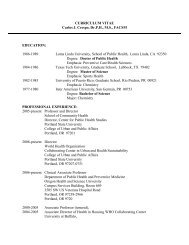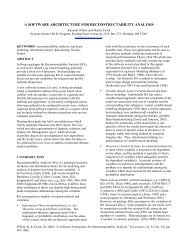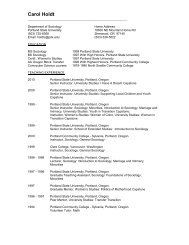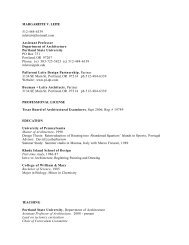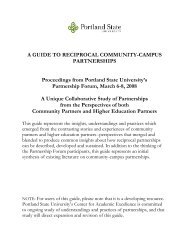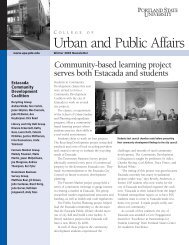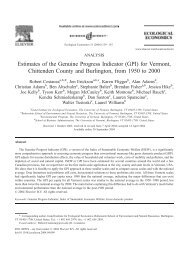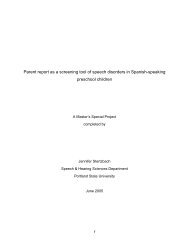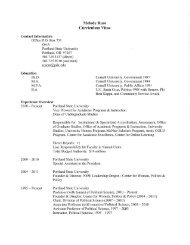Effects of integral stimulation therapy on speech - Portland State ...
Effects of integral stimulation therapy on speech - Portland State ...
Effects of integral stimulation therapy on speech - Portland State ...
Create successful ePaper yourself
Turn your PDF publications into a flip-book with our unique Google optimized e-Paper software.
(Edeal, 2008; Jakielski, et al., 2006; Jensen, 2005). Jensen (2005) used <str<strong>on</strong>g>integral</str<strong>on</strong>g><br />
<str<strong>on</strong>g>stimulati<strong>on</strong></str<strong>on</strong>g> <str<strong>on</strong>g>therapy</str<strong>on</strong>g> with a 10-year-old boy for 15 weeks. Post-treatment data suggested<br />
increased intelligibility for 2 <str<strong>on</strong>g>of</str<strong>on</strong>g> the 3 targeted ph<strong>on</strong>emes and a 5% increase in overall<br />
<strong>speech</strong> intelligibility. Similarly, Jakielski et al. (2006) treated 3 siblings diagnosed with<br />
CAS with <str<strong>on</strong>g>integral</str<strong>on</strong>g> <str<strong>on</strong>g>stimulati<strong>on</strong></str<strong>on</strong>g> <str<strong>on</strong>g>therapy</str<strong>on</strong>g>. At the end <str<strong>on</strong>g>of</str<strong>on</strong>g> the study, all 3 participants showed<br />
improved <strong>speech</strong> accuracy for target sentences. Results showed that the oldest sibling<br />
made the most progress while the youngest participant made the least progress.<br />
The most recent study <str<strong>on</strong>g>of</str<strong>on</strong>g> <str<strong>on</strong>g>integral</str<strong>on</strong>g> <str<strong>on</strong>g>stimulati<strong>on</strong></str<strong>on</strong>g> <str<strong>on</strong>g>therapy</str<strong>on</strong>g> was c<strong>on</strong>ducted by Edeal in<br />
2008. This study explored the frequency <str<strong>on</strong>g>of</str<strong>on</strong>g> repetiti<strong>on</strong> <str<strong>on</strong>g>of</str<strong>on</strong>g> target sounds in the c<strong>on</strong>text <str<strong>on</strong>g>of</str<strong>on</strong>g><br />
<str<strong>on</strong>g>integral</str<strong>on</strong>g> <str<strong>on</strong>g>stimulati<strong>on</strong></str<strong>on</strong>g> <str<strong>on</strong>g>therapy</str<strong>on</strong>g> with three children suspected <str<strong>on</strong>g>of</str<strong>on</strong>g> having CAS. The single<br />
subject, alternating treatment design explored the efficacy <str<strong>on</strong>g>of</str<strong>on</strong>g> multimodal cueing<br />
approaches with varying amounts <str<strong>on</strong>g>of</str<strong>on</strong>g> <strong>speech</strong> motor practice opportunities. Two treatment<br />
c<strong>on</strong>diti<strong>on</strong>s (target ph<strong>on</strong>emes) were chosen for each child. Each c<strong>on</strong>diti<strong>on</strong> used all <str<strong>on</strong>g>of</str<strong>on</strong>g> the<br />
comp<strong>on</strong>ents <str<strong>on</strong>g>of</str<strong>on</strong>g> <str<strong>on</strong>g>integral</str<strong>on</strong>g> <str<strong>on</strong>g>stimulati<strong>on</strong></str<strong>on</strong>g> <str<strong>on</strong>g>therapy</str<strong>on</strong>g> (cuing and motor practice), but <strong>on</strong>e demanded<br />
less practice (30 to 40 repetiti<strong>on</strong>s) <str<strong>on</strong>g>of</str<strong>on</strong>g> <strong>speech</strong> sounds during treatment sessi<strong>on</strong>s and the<br />
other required more practice (100 to 150 repetiti<strong>on</strong>s) <str<strong>on</strong>g>of</str<strong>on</strong>g> <strong>speech</strong> sounds. One <str<strong>on</strong>g>of</str<strong>on</strong>g> the<br />
participants was withdrawn from the study as his diagnosis <str<strong>on</strong>g>of</str<strong>on</strong>g> CAS and the benefits <str<strong>on</strong>g>of</str<strong>on</strong>g><br />
<str<strong>on</strong>g>integral</str<strong>on</strong>g> <str<strong>on</strong>g>stimulati<strong>on</strong></str<strong>on</strong>g> treatment were in questi<strong>on</strong>. The remaining 2 participants completed<br />
the study showing improved motor performance <str<strong>on</strong>g>of</str<strong>on</strong>g> treated sounds (in both treatment<br />
c<strong>on</strong>diti<strong>on</strong>s) in n<strong>on</strong> trained words. Integral <str<strong>on</strong>g>stimulati<strong>on</strong></str<strong>on</strong>g> <str<strong>on</strong>g>therapy</str<strong>on</strong>g> that incorporated the higher<br />
<strong>speech</strong> practice c<strong>on</strong>diti<strong>on</strong> (100 to 150 repetiti<strong>on</strong>s) yielded higher levels <str<strong>on</strong>g>of</str<strong>on</strong>g> in-sessi<strong>on</strong><br />
accuracy and generalizati<strong>on</strong> to novel words than did the c<strong>on</strong>diti<strong>on</strong> demanding fewer (30<br />
to 40) repetiti<strong>on</strong>s per sessi<strong>on</strong>. Post treatment results <str<strong>on</strong>g>of</str<strong>on</strong>g> this study illustrate that <str<strong>on</strong>g>integral</str<strong>on</strong>g><br />
25



